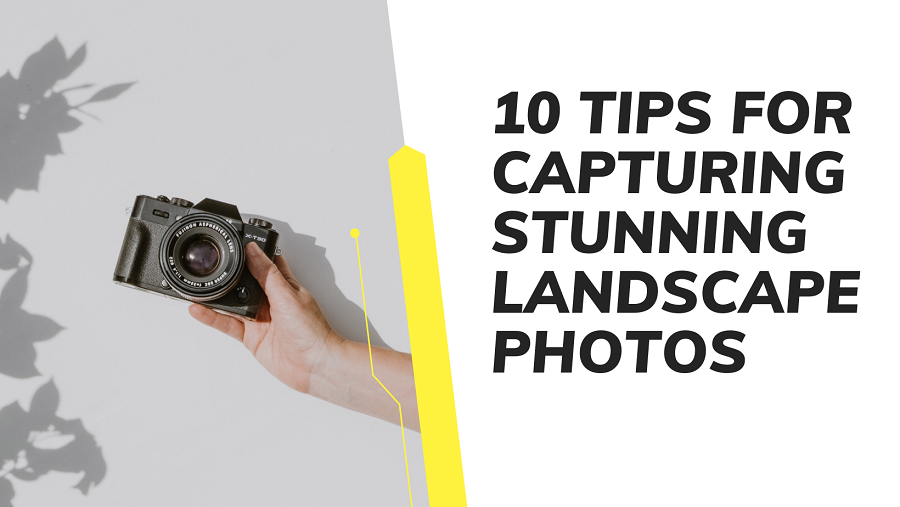Landscape photography is a wonderful way to capture the beauty of the natural world and create stunning images that can transport the viewer to far-off places or simply remind them of the beauty in their own backyard. Whether you're an amateur photographer or a seasoned pro, there are always new techniques to learn and new ways to capture the magic of a landscape.
In this article, I will provide you with 10 tips for capturing stunning landscape photos that will help you take your photography skills to the next level. From planning your shot and finding a strong focal point to experimenting with different angles and lighting conditions, these tips will help you create images that are both beautiful and memorable. So grab your camera, head outside, and let's get started!
1. Scout the location beforehand:
When it comes to capturing stunning landscape photos, scouting the location beforehand is an important step. Here are some tips to help you do this effectively:
- Research the location online: Use the internet to research the location you plan to shoot at. Look for photos others have taken there to get an idea of what to expect and to find popular viewpoints or landmarks.
- Check weather and lighting conditions: Look at the weather forecast and consider the lighting conditions during the time of day you plan to shoot. This can help you determine the best time to shoot and what type of gear you may need.
- Visit the location in person: If possible, visit the location in person before you plan to shoot. This can help you get a better sense of the landscape and find any hidden gems that might make for great photos.
- Take test shots: Once you're at the location, take some test shots to see how the lighting and landscape look through your camera. This can help you adjust your camera settings and composition to get the best shot possible.
By scouting the location beforehand, you can save time and ensure you capture the best possible images.
Also Read This: Guidelines for Using 123RF Images on Your Website: Incorporating Copyrighted Content
2. Use a tripod
Using a tripod is a valuable technique when it comes to capturing stunning landscape photos. Here are some tips to help you use a tripod effectively:
- Choose a sturdy tripod: A sturdy tripod is essential for keeping your camera steady, especially in windy conditions or when using longer exposure times. Look for a tripod made of sturdy materials, such as carbon fiber or aluminum, and with adjustable legs to ensure it is stable on uneven ground.
- Use a remote or timer: Using a remote or timer can help reduce camera shake when pressing the shutter button. This is especially important when using longer exposure times or shooting in low-light conditions.
- Adjust the tripod height: Adjusting the tripod height can help you capture the best possible shot. Try different heights and angles to find the most interesting composition.
- Use the tripod as a stabilizer: You can also use the tripod as a stabilizer by holding onto the center column or the tripod legs. This can help further reduce camera shake.
- Consider the weight and size of your gear: Make sure the tripod can support the weight of your camera and lenses. Also, consider the size of your gear when choosing a tripod as some tripods may be too small for larger cameras and lenses.
Using a tripod can help you capture sharper and more detailed landscape photos, which is especially important when shooting in low light or using longer exposure times.
Also Read This: Download the Best Funny Videos GIF from 9GAG with This Tool
3. Shoot during the golden hour
The golden hour, which is the hour after sunrise or before sunset, is often considered the best time to shoot landscape photos due to the soft, warm light that can enhance the beauty of the scenery. Here are some tips for shooting during the golden hour:
- Plan ahead: Check the weather forecast and the sunrise and sunset times for the location you plan to shoot. Arrive early to allow yourself enough time to set up and be ready when the light is at its best.
- Look for interesting subjects: Use the golden hour to capture interesting subjects such as silhouettes, reflections or backlit subjects. Experiment with different angles and compositions to create unique images.
- Use a tripod: Since the light during the golden hour is often low, a tripod can help you keep your camera steady and avoid blurry images.
- Adjust the white balance: The golden hour can create warm, golden tones in your images. Adjust the white balance to capture the colors accurately and make the most of the warm light.
- Experiment with different lenses: Use a wide-angle lens to capture more of the landscape or a telephoto lens to isolate specific elements and create a more dramatic effect.
Shooting during the golden hour can produce stunning landscape photos with soft, warm light and beautiful colors. It's important to plan ahead and experiment with different techniques to make the most of this special time of day.
Also Read This: Learn How to Sell Music on SoundCloud in This Guide
4. Use a polarizing filter
Using a polarizing filter is a useful technique when it comes to capturing stunning landscape photos. Here are some tips for using a polarizing filter effectively:
- Understand how a polarizing filter works: A polarizing filter can reduce glare and reflections in your images and enhance colors in the sky and landscape. It works by blocking certain types of light waves and allowing others to pass through.
- Choose the right filter size: Make sure you choose a filter that fits your lens diameter. Many filters come with different thread sizes to fit a variety of lenses.
- Adjust the filter angle: The effectiveness of the polarizing filter depends on the angle of the sun and the direction you are shooting. Adjust the filter angle until you see the desired effect in the viewfinder.
- Experiment with different settings: Try different filter settings to see how they affect your images. This can help you achieve the desired effect for your landscape.
- Be aware of vignetting: Using a polarizing filter can cause vignetting, which is when the corners of the image appear darker. Make sure to check for vignetting when using a polarizing filter and adjust accordingly.
Using a polarizing filter can help you achieve clearer, more vibrant landscape photos with reduced glare and enhanced colors. It's important to understand how the filter works and experiment with different settings to get the best results.
Also Read This: Using Getty Images for Educational Purposes: Guidelines and Considerations
5. Use a wide-angle lens
Using a wide-angle lens is a valuable technique when it comes to capturing stunning landscape photos. Here are some tips for using a wide-angle lens effectively:
- Choose the right focal length: Wide-angle lenses typically have a focal length of 14-35mm, which allows you to capture a wider field of view. Choose the right focal length based on the size of the landscape and the composition you want to achieve.
- Consider the foreground: Wide-angle lenses can capture both the foreground and background in a single frame, so it's important to consider the foreground when composing your shot. Look for interesting elements, such as rocks or flowers, to include in the foreground and create depth in your image.
- Use leading lines: Leading lines can help draw the viewer's eye into the image and create a sense of depth. Look for natural lines in the landscape, such as rivers or roads, to use as leading lines.
- Avoid distortion: Wide-angle lenses can cause distortion, especially around the edges of the frame. Be aware of this and adjust your composition accordingly to avoid distracting distortion.
- Experiment with different angles: Try different angles and perspectives to capture the landscape in new and interesting ways. Get low to the ground or climb up high to capture a unique viewpoint.
Using a wide-angle lens can help you capture more of the landscape in a single frame and create a sense of depth and dimension. It's important to consider the foreground, leading lines, and distortion when using a wide-angle lens and experiment with different angles to find the most interesting composition.
Also Read This: List of LinkedIn Remote Jobs Worldwide
6. Look for interesting elements
When scouting for locations, keep an eye out for interesting elements in the foreground, such as rocks, flowers, or water features.
- Get low: Shooting from a low angle can bring foreground elements into focus and make them more prominent in your image.
- Use leading lines: Incorporating leading lines in the foreground can help guide the viewer's eye through the image and create a sense of depth.
- Create balance: Use foreground elements to create a sense of balance in your composition. For example, you might place a large rock or tree in the foreground to balance out the landscape in the background.
- Experiment with aperture: Using a wider aperture (lower f-stop number) can create a shallow depth of field and blur the foreground while using a narrower aperture (higher f-stop number) can bring the foreground and background into sharper focus.
By including foreground interest in your landscape photos, you can add depth and visual interest to your images, as well as create a sense of balance and harmony in your compositions. Keep an eye out for interesting elements in the foreground, get low, and experiment with different techniques to find the most effective approach for each scene.
Also Read This: The Complete Guide on How to Download TED Videos with Subtitles
7. Play with the aperture
Playing with the aperture is a useful technique for creating different effects in your landscape photos. Here are some tips for using the aperture effectively:
- Use a narrow aperture for a deep depth of field: If you want to capture a landscape with as much detail as possible, use a narrow aperture (higher f-stop number) to create a deep depth of field. This will keep both the foreground and background in sharp focus.
- Use a wide aperture for a shallow depth of field: If you want to create a more dreamy or artistic effect, use a wider aperture (lower f-stop number) to create a shallow depth of field. This will blur the foreground or background and draw attention to a specific element in the image.
- Experiment with different aperture settings: Try different aperture settings to see how they affect your image. This can help you achieve the desired effect for your landscape.
- Use aperture priority mode: Aperture priority mode is a shooting mode that lets you control the aperture while the camera automatically adjusts the shutter speed to maintain the correct exposure. This is a great way to experiment with different aperture settings without worrying about the other camera settings.
- Be aware of diffraction: Using a very narrow aperture can cause diffraction, which can reduce the sharpness of your image. Be aware of this and use a slightly wider aperture if you notice any loss of sharpness.
By playing with the aperture, you can create different effects in your landscape photos, from a deep depth of field to a shallow depth of field. It's important to experiment with different aperture settings to achieve the desired effect and be aware of diffraction when using a narrow aperture.
Also Read This: Here Is the Simplest Way to Learn How to Download a Reel from Facebook Today
8. Experiment with different angles and perspectives
Experimenting with different angles and perspectives is a great way to capture unique and compelling landscape photos. Here are some tips for finding interesting angles and perspectives:
- Get low: Shooting from a low angle can create a unique perspective and add a sense of depth to your images. Try getting down on the ground or using a low tripod to capture this perspective.
- Look for elevated viewpoints: Capturing a landscape from an elevated viewpoint can offer a different perspective and showcase the landscape in a new way. Look for high vantage points, such as hills or mountains, or consider using a drone to capture aerial shots.
- Shoot at different times of day: Experimenting with different times of day can offer different lighting and atmosphere, which can change the mood and impact of your landscape photos. Consider shooting at dawn, dusk, or even at night to capture a unique perspective.
- Use different lenses: Changing lenses can offer different perspectives and focal lengths, which can impact the look and feel of your images. Consider using a telephoto lens to compress the scene or a fisheye lens for a distorted perspective.
- Be creative: Don't be afraid to experiment with different angles and techniques to capture a unique and compelling landscape photo. Look for interesting compositions, foreground elements, and leading lines to create a dynamic image.
By experimenting with different angles and perspectives, you can capture unique and compelling landscape photos that stand out from the rest. Get low, look for elevated viewpoints, shoot at different times of day, use different lenses, and be creative to find the most interesting and dynamic composition for your landscape photos.
Also Read This: How to Delete Pictures on Foap by Phone: A Step-by-Step Tutorial
9. Use the rule of thirds
The rule of thirds is a composition technique that can be used to create more visually appealing landscape photos. The idea behind the rule of thirds is to imagine the image divided into thirds both horizontally and vertically, resulting in a grid of nine equal parts. The main subject of the image is then placed at one of the intersections of these lines or along one of the lines itself, rather than being centered in the frame.
Here are some tips for using the rule of thirds in landscape photography:
- Identify the main subject: Determine the main subject of your image and how you want to position it in the frame.
- Divide the frame into thirds: Visualize the grid of nine equal parts and use it to position your subject in the frame.
- Place the subject at an intersection or along a line: Consider placing the subject at one of the intersections of the grid lines or along one of the lines themselves.
- Use leading lines: Incorporate leading lines into your composition to draw the viewer's eye to the subject and create a sense of depth.
- Don't be afraid to break the rules: While the rule of thirds is a useful guideline, it's not a hard and fast rule. Don't be afraid to break it if it results in a more visually appealing image.
By using the rule of thirds, you can create more visually appealing landscape photos that draw the viewer's eye to the main subject and create a sense of balance and harmony in the composition. Remember to identify the main subject, divide the frame into thirds, place the subject at an intersection or along a line, incorporate leading lines, and don't be afraid to break the rules if it results in a more compelling image.
Also Read This: Save Reddit Videos on Mobile with This Must-Have Tool
10. Don't be afraid to edit:
Editing is an important step in the process of creating stunning landscape photos. While it's important to capture a good image with a camera, editing can help you enhance the image and bring out its full potential. Here are some tips for editing your landscape photos:
- Start with a good base image: Begin by selecting a strong image with good composition, exposure, and focus.
- Use editing software: Use editing software such as Adobe Lightroom or Photoshop to adjust elements such as exposure, contrast, color balance, and saturation.
- Be subtle: Avoid over-editing your photos, as this can make them look unrealistic and overly processed. Instead, make subtle adjustments to enhance the image without making it look artificial.
- Crop and straighten: Consider cropping the image to remove any distracting elements or to improve the composition. Also, use the straightening tool to correct any crooked horizons.
- Experiment with different styles: Use editing to experiment with different styles and effects, such as black and white or sepia tones, to create a unique and compelling image.
- Save a copy of the original: Always save a copy of the original image so that you can go back to it if needed.
Remember, editing is a tool that can help you enhance your landscape photos and bring out their full potential. Start with a good base image, use editing software, be subtle, crop and straighten, experiment with different styles, and save a copy of the original. By doing so, you can create stunning landscape photos that truly capture the beauty of the natural world.
Also Read This: Top Examples of Linkedin Bio for Writing a Perfect Bio
FAQ
What is the most important piece of equipment for capturing stunning landscape photos?
While there are several pieces of equipment that can be helpful in capturing stunning landscape photos, the most important one is likely a tripod. A tripod can help keep your camera steady and prevent blurry or shaky images, especially in low-light conditions or when using slower shutter speeds. It also allows you to experiment with different angles and compositions without having to hold your camera steady for an extended period of time.
What is the rule of thirds and how can it be used in landscape photography?
The rule of thirds is a composition guideline in photography that suggests dividing the frame into thirds both horizontally and vertically, creating a grid of nine equal parts. The idea is to place the main subject or focal point of the image at one of the intersections of these lines, rather than in the center of the frame. This can create a more visually interesting and dynamic image that draws the viewer's eye into the scene. In landscape photography, the rule of thirds can be used to position elements such as mountains, trees, and bodies of water off-center, creating a more balanced and pleasing composition.
What are some natural elements I can use as leading lines in my landscape photos?
There are many natural elements that can be used as leading lines in landscape photos. Here are a few examples:
- Rivers or streams: These can create a strong visual flow in your image and lead the viewer's eye through the scene.
- Paths or roads: These can create a sense of depth and lead the viewer's eye into the distance.
- Fences or walls: These can create a sense of structure and provide a leading line that guides the viewer's eye through the scene.
- Tree branches or trunks: These can create a natural frame or leading line that guides the viewer's eye through the scene.
- Mountain ridges or hills: These can create a sense of depth and lead the viewer's eye into the distance.
Remember, any natural element with a strong line or shape can be used as a leading line in your landscape photos. Be creative and experiment with different angles and compositions to find what works best for your scene.
Can I capture stunning landscape photos with just a smartphone camera or do I need a professional camera?
Yes, it is possible to capture stunning landscape photos with just a smartphone camera. Many modern smartphones come equipped with advanced camera technology and features such as wide-angle lenses, portrait mode, and HDR (high dynamic range) capabilities that can help you capture stunning landscape photos. However, professional cameras do have some advantages such as interchangeable lenses and better low-light performance, which can be helpful in certain situations. Ultimately, the quality of the final image depends on a combination of factors, including the photographer's skill, the lighting conditions, and the composition of the scene. So, whether you are using a smartphone or a professional camera, it is important to focus on the fundamentals of composition, lighting, and timing to capture stunning landscape photos.
Conclusion
In conclusion, capturing stunning landscape photos requires a combination of skill, creativity, and patience. By following the tips outlined in this blog post, such as using a tripod, utilizing the rule of thirds, finding a strong focal point, and experimenting with different lighting conditions, you can elevate your landscape photography to new heights. Additionally, it is important to remember that the most important aspect of any photograph is the story it tells and the emotions it evokes. With practice and perseverance, you can capture breathtaking landscape photos that transport the viewer to a different time and place, leaving a lasting impression on those who view them.















